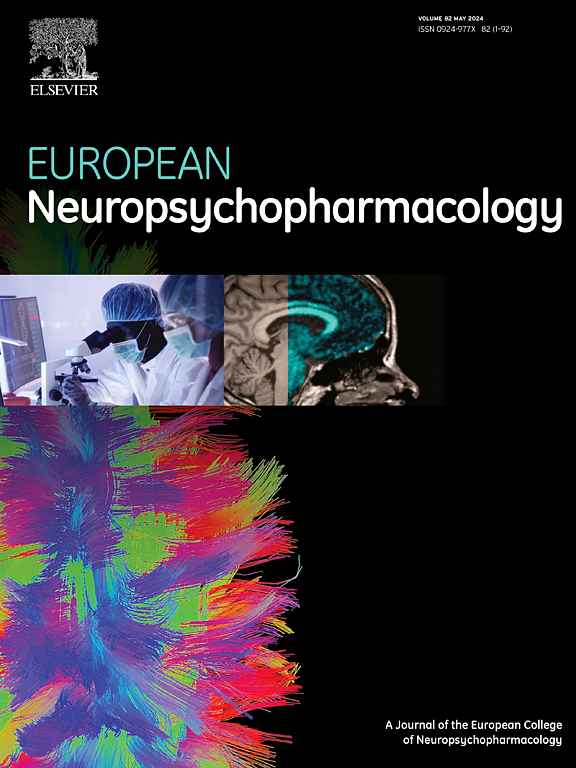Predicted plasma proteomics from genetic scores and treatment outcomes in major depression: a meta-analysis
IF 6.1
2区 医学
Q1 CLINICAL NEUROLOGY
引用次数: 0
Abstract
Proteomics has been scarcely explored for predicting treatment outcomes in major depressive disorder (MDD), due to methodological challenges and costs. Predicting protein levels from genetic scores provides opportunities for exploratory studies and the selection of targeted panels. In this study, we examined the association between genetically predicted plasma proteins and treatment outcomes – including non-response, non-remission, and treatment-resistant depression (TRD) – in 3559 patients with MDD from four clinical samples.
Protein levels were predicted from individual-level genotypes using genetic scores from the publicly available OmicsPred database, which estimated genetic scores based on genome-wide genotypes and proteomic measurements from the Olink and SomaScan platforms. Associations between predicted protein levels and treatment outcomes were assessed using logistic regression models, adjusted for potential confounders including population stratification. Results were meta-analysed using a random-effects model. The Bonferroni correction was applied.
We analysed 257 proteins for Olink and 1502 for SomaScan; 111 proteins overlapped between the two platforms. Despite no association was significant after multiple-testing correction, many top results were consistent across phenotypes, in particular seven proteins were nominally associated with all the analysed outcomes (CHL1, DUSP13, EVA1C, FCRL2, KITLG, SMAP1, and TIM3/HAVCR2). Additionally, three proteins (CXCL6, IL5RA, and RARRES2) showed consistent nominal associations across both the Olink and SomaScan platforms.
The convergence of results across phenotypes is in line with the hypothesis of the involvement of immune-inflammatory mechanisms and neuroplasticity in treatment response. These results can provide hints for guiding the selection of protein panels in future proteomic studies.
从遗传评分和重度抑郁症治疗结果预测血浆蛋白质组学:荟萃分析
由于方法上的挑战和成本问题,蛋白质组学在预测重度抑郁症(MDD)治疗结果方面的研究很少。从遗传评分预测蛋白质水平为探索性研究和选择目标群体提供了机会。在这项研究中,我们研究了来自四个临床样本的3559名重度抑郁症患者的基因预测血浆蛋白与治疗结果(包括无反应、无缓解和治疗抵抗性抑郁症(TRD))之间的关系。蛋白质水平的预测来自个人水平的基因型,使用来自公开的OmicsPred数据库的遗传评分,该数据库基于Olink和SomaScan平台的全基因组基因型和蛋白质组测量来估计遗传评分。使用逻辑回归模型评估预测蛋白水平与治疗结果之间的关系,并对包括人群分层在内的潜在混杂因素进行调整。使用随机效应模型对结果进行meta分析。应用Bonferroni校正。我们分析了257个Olink蛋白和1502个SomaScan蛋白;111种蛋白质在两个平台之间重叠。尽管经过多次测试校正后没有显著的相关性,但许多顶级结果在表型上是一致的,特别是七种蛋白质在名义上与所有分析结果相关(CHL1, DUSP13, EVA1C, FCRL2, KITLG, SMAP1和TIM3/HAVCR2)。此外,三种蛋白(CXCL6、IL5RA和RARRES2)在Olink和SomaScan平台上显示出一致的名义关联。跨表型结果的趋同与免疫炎症机制和神经可塑性参与治疗反应的假设是一致的。这些结果可为今后蛋白质组学研究中蛋白质板的选择提供指导。
本文章由计算机程序翻译,如有差异,请以英文原文为准。
求助全文
约1分钟内获得全文
求助全文
来源期刊

European Neuropsychopharmacology
医学-精神病学
CiteScore
10.30
自引率
5.40%
发文量
730
审稿时长
41 days
期刊介绍:
European Neuropsychopharmacology is the official publication of the European College of Neuropsychopharmacology (ECNP). In accordance with the mission of the College, the journal focuses on clinical and basic science contributions that advance our understanding of brain function and human behaviour and enable translation into improved treatments and enhanced public health impact in psychiatry. Recent years have been characterized by exciting advances in basic knowledge and available experimental techniques in neuroscience and genomics. However, clinical translation of these findings has not been as rapid. The journal aims to narrow this gap by promoting findings that are expected to have a major impact on both our understanding of the biological bases of mental disorders and the development and improvement of treatments, ideally paving the way for prevention and recovery.
 求助内容:
求助内容: 应助结果提醒方式:
应助结果提醒方式:


